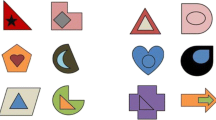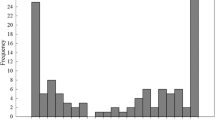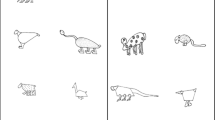Abstract
Recently, Redford (2010) found that monkeys seemed to exert meta-cognitive control in a category-learning paradigm. Specifically, they selected more trials to view as the difficulty of the category-learning task increased. However, category-learning difficulty was determined by manipulating the family resemblance across the to-be-learned exemplars. Although this effectively influenced the learning difficulty, difficulty was confounded with novelty. For instance, a weak family resemblance made category learning difficult, but also increased the amount of perceptual change from trial to trial. The current research rules out novelty in favor of difficulty by manipulating the number of dots involved in the dot distortions while controlling the amount of perceptual change.
Similar content being viewed by others
References
BERAN, M. J., SMITH, J. D., REDFORD, J. S., & WASHBURN, D. A. (2006). Rhesus macaque. (Macaca mulatto) monitor uncertainty during numerosity judgments. Journal of Experimental Psychology: Animal Behavior Processes, 32, 111–119.
DUNLOSKY, J., & NELSON, T. O. (1992). Importance of the kind of cue for judgments of learning (Jol) and the delayed-Jol effect. Memory & Cognition, 20, 374–380.
FANTZ, R. (1958). Pattern vision in young infants. The Psychological Record, 8, 43–47.
GOLUB, M. S., & GERMANN, S. L. (1998). Perinatal bupivacaine and infant behavior in rhesus monkeys. Neurotoxicology and Teratology, 20, 29–41.
HAMPTON, R. R. (2001). Rhesus monkeys know when they remember. Proceedings of the National Academy of Sciences of the United States of America, 98, 5359–5362.
HOMA, D., & CULTICE, J. C. (1984). Role of feedback, category size, and stimulus distortion on the acquisition and utilization of ill-defined categories. Journal of Experimental Psychology: Teaming, Memory, and Cognition, 10, 83–94.
KORIAT, A., & BIORK, R. A. (2005). Illusions of competence in monitoring one’s knowledge during study. Journal of Experimental Psychology: Teaming, Memory, and Cognition, 31, 187–194.
KORIAT, A., & MAAYAN, H. (2005). The effects of encoding fluency and retrieval fluency on judgments of learning. Journal of Memory and Tanguage, 52, 478–492.
KORNELL, N., SON, L. K., & TERRACE, H. S. (2007). Transfer of metacognitive skills and hint seeking in monkeys. Psychological Science, 18, 64–71.
NELSON, T. O., & NARENS, L. (1990). Metamemory: A. theoretical framework and new findings. In G. H. Bower (Ed.). The psychology of learning and motivation. (pp. 125–141). New York: Academic Press.
POSNER, M. I., GOLDSMITH, R., & WELTON, K. E., JR. (1967). Perceived distance and the classification of distorted patterns. Journal of Experimental Psychology, 73, 28–38.
QUINN, P., & EIMAS, P. (1986). Pattern-line effects and units of visual processing in infants. Infant Behavior and Development, 9, 57–70.
REDFORD, J. S. (2010). Evidence of metacognitive control by humans and monkeys in a perceptual categorization task. Journal of Experimental Psychology: Teaming, Memory, and Cognition, 36, 248–254.
RIETH, C., & SIRETEANU, R. (1994). Texture segmentation and visual search based on orientation contrast: An infant study with the familiarization/ novelty preference method. Infant Behavior and Development, 17, 359–369.
RUMBAUGH, D. M., RICHARDSON, W. K., WASHBURN, D. A., SAVAGE-RUMBAUGH, E. S., & HOPKINS, W. D. (1989). Rhesus monkeys (Macaca mulatto), video tasks, and implications for stimulus-response spatial contiguity. Journal of Comparative Psychology, 103, 32–38.
SAMUELS, C. A., & EWY, R. (1985). Aesthetic perception of faces during infancy. British Journal of Developmental Psychology, 3, 221–228.
SERRA, M. J., & DUNLOSKY, J. (2005). Does retrieval fluency contribute to the underconfidence-with-practice effect. Journal of Experimental Psychology: Learning, Memory, and Cognition, 31, 1258–1266.
SHIELDS, W. E., SMITH, J. D., GUTTMANNOVA, K., & WASHBURN, D. A. (2005) Confidence judgments by humans and rhesus monkeys. Journal of General Psychology, 132, 165–186.
SMITH, J. D., BERAN, M. J., REDFORD, J. S., & WASHBURN, D. A. (2006). Dissociating uncertainty responses and reinforcement signals in the comparative study of uncertainty monitoring. Journal of Experimental Psychology: General, 135, 282–297.
SMITH, J. D., & MINDA, J. P. (2002). Distinguishing prototype-based and exemplar-based processes in dot-pattern category learning. Journal of Experimental Psychology: Learning, Memory, and Cognition, 28, 800–811.
SMITH, J. D., REDFORD, J. S., GENT, L. C., & WASHBURN, D. A. (2005). Visual search and the collapse of categorization. Journal of Experimental Psychology: General, 134, 443–460.
SMITH, J. D., REDFORD, J. S., HAAS, S. M., COUTINHO, M. V. C., & COUCHMAN, J. J. (2008). The comparative psychology of same-different judgments by human. (Homo sapiens) and monkey (Macaca mulatto). Journal of Experimental Psychology: Animal Behavior Processes, 34, 361–374.
SMITH, J. D., SHIELDS, W. E., ALLENDOERFER, K. R., & WASHBURN, W. A. (1998). Memory monitoring by animals and humans. Journal of Experimental Psychology: General, 127, 227–250.
SMITH, J. D., SHIELDS, W. E., SCHULL, J., & WASHBURN, D. A. (1997). The uncertain response in humans and animals. Cognition, 62, 75–97.
SON, L. K., & KORNELL, N. (2005). Metaconfidence judgments in rhesus macaques: Explicit versus implicit mechanisms. In H. S. Terrace & J. Metcalfe (Eds.). The missing link in cognition: Origins of self-reflective consciousness (pp. 296–320). New York: Oxford University Press.
THIEDE, K. W. (1999). The importance of monitoring and self-regulation during multitrial learning. Psychonomic Bulletin & Review, 6, 662–667.
THIEDE, K. W., ANDERSON, M. C. M., & THERRIAULT, D. (2003). Accuracy of metacognitive monitoring affects learning of texts. Journal of Educational Psychology, 95, 66–73.
THOMPSON, L. A. & PETRILL, S. A. (1994). Longitudinal predictions of school-age cognitive abilities from infant novelty preference. In J. C. Defries, R. Plomin, & D. W. Plomin (Eds.). Nature and nurture during middle childhood (pp. 77–85). Maiden, MA: Blackwell Publishing.
WASHBURN, D. A., & RUMBAUGH, D. M. (1992). Testing primates with joystick-based automated apparatus: Lessons from the Language Research Center’s Computerized Test System. Behavior Research Methods, Instruments & Computers, 24, 157–164.
Author information
Authors and Affiliations
Corresponding author
Additional information
Preparation of this article was supported by Grant HD-38051 from the National Institute of Child Health and Human Development and by Grant BCS-0634662 from the National Science Foundation. The opinions expressed are those of the author and do not represent the views of either funding body.
The author would like to thank Keith Thiede for his help in the preparation of this article.
Rights and permissions
About this article
Cite this article
Redford, J.S. Humans and Monkeys Exert Metacognitive Control Based on Learning Difficulty in a Perceptual Categorization Task. Psychol Rec 60, 563–576 (2010). https://doi.org/10.1007/BF03395732
Published:
Issue Date:
DOI: https://doi.org/10.1007/BF03395732




